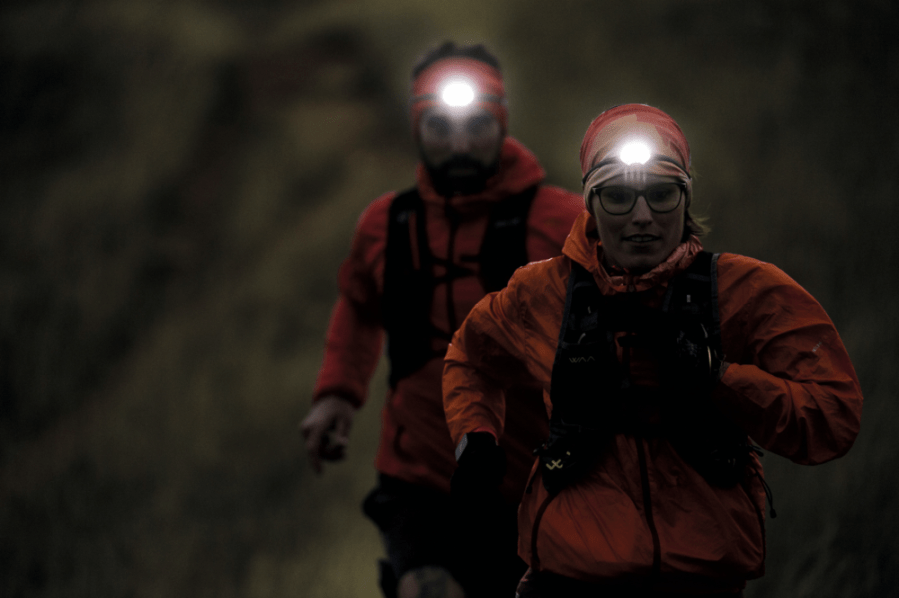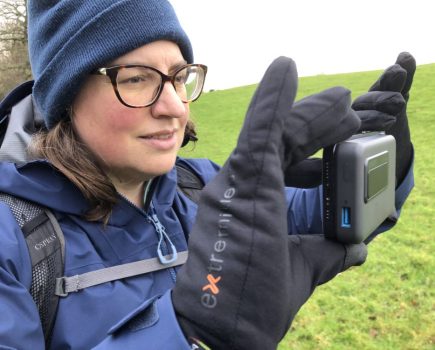A headlamp is an essential item and there is a large array of excellent ones to choose from. Every year more powerful ones appear. Some head torches are extremely bright, up to 1600 lumens, and can throw a beam over 200 metres. How much light do you actually need though? From my testing of the best head torches, I think 200-300 lumens and a beam that goes 75-100 metres is fine for hillwalking. Indeed, most of the time even that much brightness isn’t needed.
Main image: The Petzl Iko Core won Chris’ Best in Test | Credit: Petzl
Other factors need considering when choosing a head torch, not just power. Battery life, battery type, ease of use, comfort, variable lighting, size and weight are all important. Battery life depends in part on how you use a headlamp. Full power uses batteries fast so it’s best not to have more brightness than you need. Most of the time a headlamp doesn’t need to be on full power. Spare batteries or a power pack are always worth carrying as is a second headlamp. It’s not easy to change batteries in the dark and charging a headlamp can take a long time so isn’t something you want to be doing when out on a walk, except overnight in camp or in your pack after you’ve swapped it for a fully charged one.
Having spot and flood beams does make a difference. The first can be used to light the route far ahead, the second to see what’s around you or light up a tent. Switching between them shouldn’t be difficult though. Coming off the hill on a dark night in the rain feeling weary is not the time to try and remember a series of button presses in order to switch from spot to flood or increase or decrease brightness. Many headlamps now have combined spot and flood beams that cast a wide light but have a brighter one in the centre.
TGO’s pick of the best head torches
I have tested a selection of the best head torches available, ranging from budget-friendly options for walking in any season but Winter to head torches suitable for all mountain use.
Petzl Iko Core
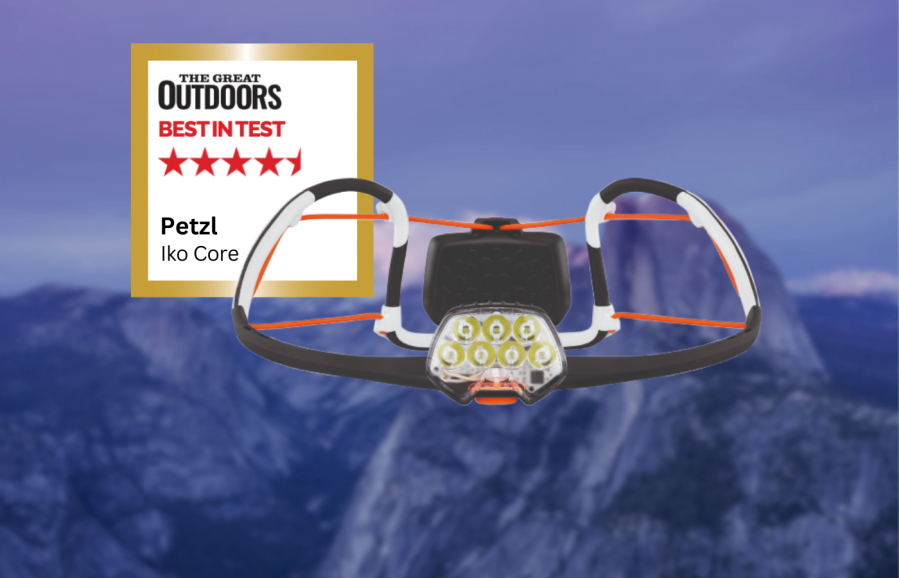
Chris Townsend’s Best in Test
The Iko Core is my favourite of the headlamps tested, offering a great deal of comfort for little weight.- Lightweight
- Very comfortable
- Can use AAA batteries
- Battery cover awkward to remove
- No red light
| Quick specs | |
|---|---|
| RRP: £76.49 | $89.95 Weight: 105g Power Source: 2400mAh Li-ion rechargeable Battery Life: 7 – 350 hours Brightness: 6 – 500 lumens / 12 – 120 metres Features: 3 light levels, dimming, proximity and distance modes, red, green, and blue lights, lock mode, waterproof (IPX67), recycled headband www.petzl.com |
The Petzl Iko Core is my favourite of the headlamps tested – not because of the actual lamp, though that is fine, but because of the innovative semi-rigid headband which is far more comfortable than any other headlamp headband I’ve used. Once adjusted it’s barely noticeable. It’s very thin and so less sweaty than standard headbands too.
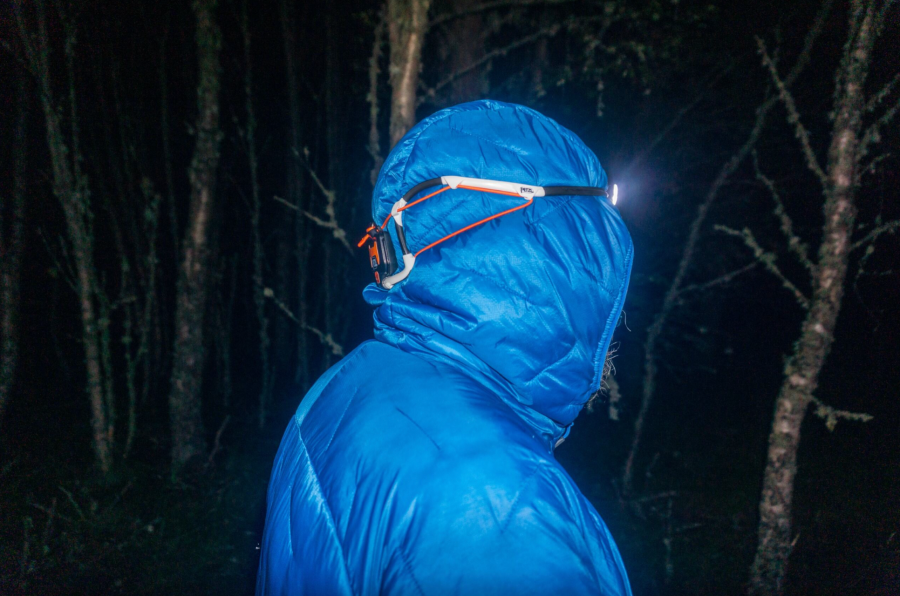
The Petzl Iko core has the lamp, which is very thin, at the front, and the battery pack at the back, which helps the unit balance well on the head. The cable connecting the lamp to the battery runs inside the headband. The battery is a rechargeable one but it is removable so you can swap it with a spare or use three AAA batteries rather than have to wait while it recharges. Getting the battery case cover off is a little awkward though.
The light is simple and easy to use. There’s a single button underneath the array of eight LEDs. Single presses cycle through the three light levels. However a single press switches the light off in any mode after the lamp has been on for only 1.6 seconds or more, which is slightly annoying if you just want to change the level.
Read Chris’ full review of the Petzl Iko Core.
Black Diamond Storm 500-R
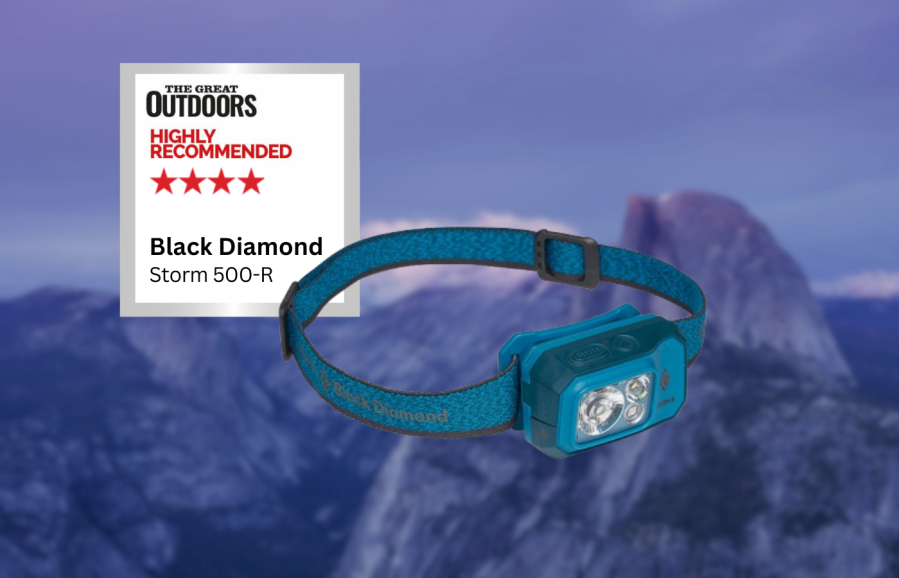
Chris Townsend highly recommends
Black Diamond have made a powerful and bright head torch at a decent price.- Battery life
- Dimming
- Distance and proximity modes
- Coloured LEDs
- Lock
- Waterproof
- Cost
- Small button
- Micro-USB charging
| Quick Specs | |
|---|---|
| RRP: £70 | $89.77 Weight: 81g Power Source: 1250 mAh CORE rechargeable battery/ 3 AAA batteries Battery Life: 2.5 hours – 100 hours Brightness: 6 – 500 lumens/10 – 100 metres Features: semi-rigid ergonomic headband, 3 light levels, wide or mixed beam, weather resistant (IPX4), lock function www.blackdiamondequipment.com |
The Storm 500-R is the most powerful of Black Diamond’s R series headlamps with the brightest beam and the longest battery life. It’s still not that heavy and sits comfortably on the front of the head. The lamp doesn’t pivot as much as most others. I haven’t found this a big problem. Unlike most of the other headlamps tested the Black Diamond Storm 500-R has the old micro-USB connection for charging rather than the newer USB-C, which may mean carrying an extra cable or adapter if you have other devices with USB-C connections.
The Black Diamond Storm 500-R is suitable for year-round use and comes at a good price.
Read Chris’ full review of the Black Diamond Storm 500-R.
Petzl Swift RL
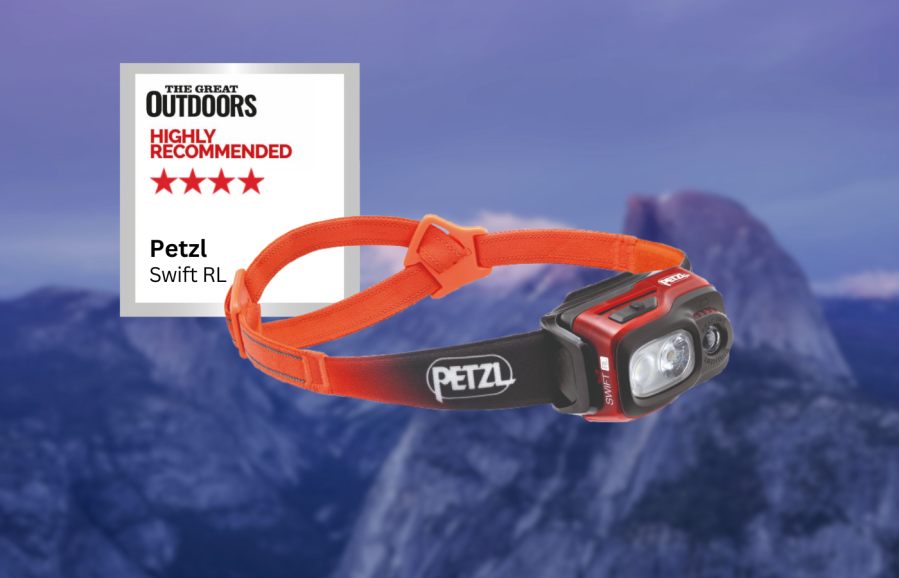
Chris Townsend highly recommends
Petzl have improved upon the reactive lighting to make this otherwise middling lamp one of the best I tested.- Reactive lighting
- Small button
| Quick Specs | |
|---|---|
| RRP: £115 | $147.41 Weight: 103g Power Source: 2350 mAh rechargeable battery Battery Life: 2 – 100 hours Brightness: 10 -1100 lumens / 12-155 metres Features: reactive lighting, mixed beam pattern, 3 light levels, red light, weather-resistant (IPX4) www.petzl.com |
The Petzl Swift RL was the first headlamp with lighting that adjusted the intensity and spread of the beam depending on where you look so pressing button isn’t needed. Petzl call this reactive lighting. This has been improved with the latest version of the Swift so that the transition is quite smooth. It could be a bit jerky with the original. The new model also has slightly longer battery life and a more powerful light that reaches further. The reactive lighting is so good that you don’t really need to use standard lighting, which is available with three lighting levels. In reactive mode how long the battery lasts varies with how you use it. With the lowest Max Burn Time setting this runs from 10 to 70 hours. I found this setting fine for walking on clear paths and tracks.
The price and weight of the Swift RL put it roughly in the middle of the headlamps tested. The reactive lighting makes it one of the best tested.
Read Chris’ full review of the Petzl Swift RL.
Ledlenser HF6R Core
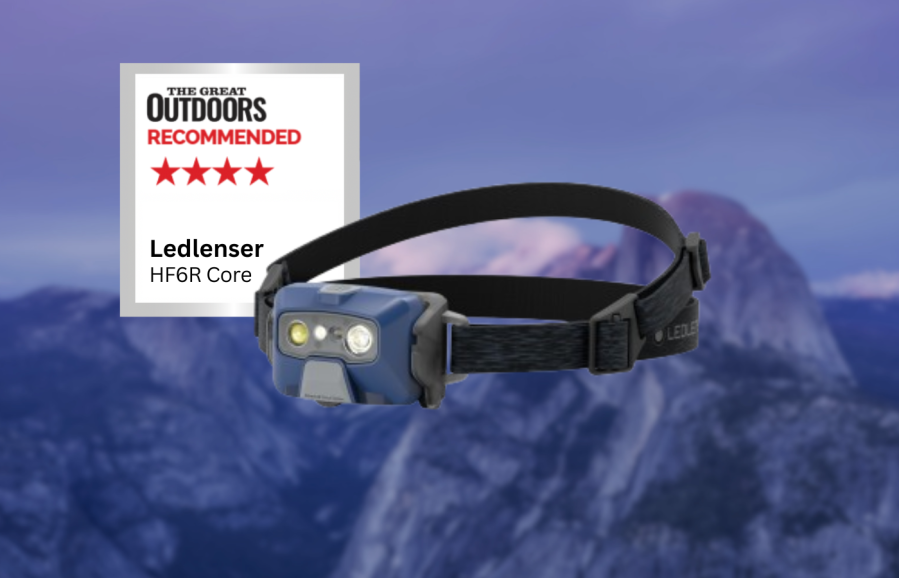
Chris Townsend recommends
Overall, this is a great head torch slightly let down by its weight and charging system.- Control wheel
- Seamless ‘spot to flood’
- Battery life
- Waterproof
- Cost
- Quite heavy
- Proprietary charging system
| Quick Specs | |
|---|---|
| RRP: £68 | $87.17 Weight: 129g Power Source: 2000 mAh rechargeable Battery Life: 3 – 60 hours Brightness: 20 – 800 lumens / 25 – 160 metres Features: 4 light levels, red light, seamless spot to flood focus, lock mode, waterproof (IP68) www.ledlenser.co.uk |
Made from aluminium, not plastic like most headlamps, the Ledlenser HF6R Core feels tough and is quite heavy for the reasonably compact size. All the weight is at the front but it has an unusual double headband that does support it well. An excellent feature is the control wheel under the lamp. With this you can go from spot to flood and back in the three main lighting modes. The fourth mode is a burst of very bright light that only stays on for a few seconds. The low power mode is brighter than on many headlamps.
The button is quite big and easy to use with gloves. Like other Ledlenser headlamps, the HF6R has a proprietary magnetic charging system rather than the USB system used by most headlamps which means you need to carry a separate cable to recharge it while in the hills.
Read Chris’ full review of the Ledlenser HF6R Core.
Silva Free 1200XS
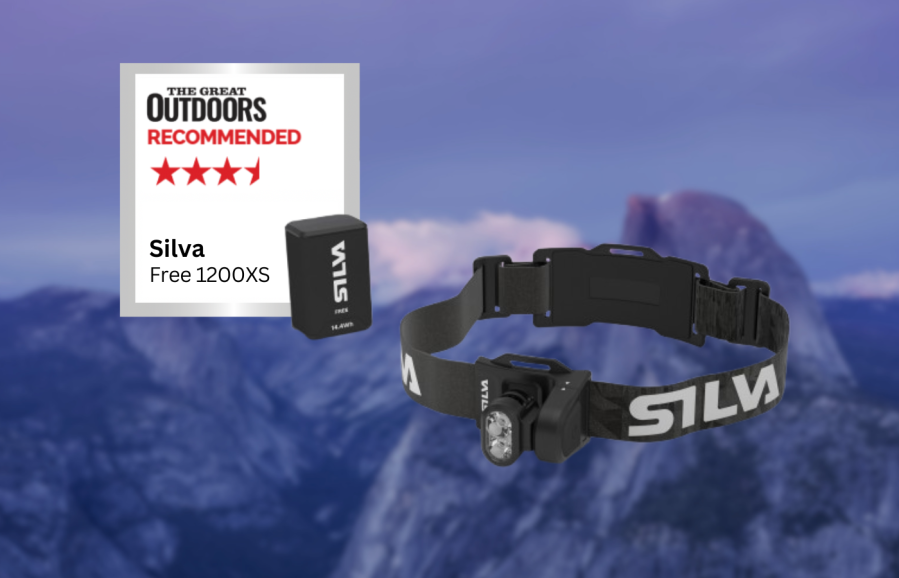
Chris Townsend Recommends
The Free series of headlamps are innovative, the first headlamps with interchangeable batteries and lamps. But this comes at a cost and a few compromises.- Simple controls
- Modular
- Cable in headband
- Battery life
- No red light
- Heavy and exprensive
| Quick specs | |
|---|---|
| RRP: £140 | $150 Weight: 230g Power: 2000mAh Li-ion rechargeable battery Battery Life: 1-2 hours – 15 hours Brightness: 80 – 1200 lumens/ 45 metres – 150 metres Features: modular – battery and lamp can be changed, 3 light levels, headband with integrated electronics, water resistant (IPX5), combined long reach spotlight and close flood light https://silvasweden.uk |
The Silva Free series of headlamps are innovative, the first headlamps with interchangeable batteries and lamps and that’s no different in the Silva Free 1200XS. This is a superb idea and Silva deserve praise and the awards it has won. But the first iterations of the Free series are heavy. The cost is very high too. The 1200XS is the lightest and is still much heavier than the other headlamps tested. The run time is short too.
Against this, the Silva Free 1200XS is well-designed and works well. The battery sits on the back of the head. The cable attaching it to the light unit is integrated into the headband rather than hanging loose, an excellent feature. The small lamp unit pivots through 90° and stays in place once adjusted.
The design is brilliant but it would be good to see a lighter option with a longer runtime.
Read Chris’ full review of the Silva Free 1200XS.
Nitecore HC65 UHE
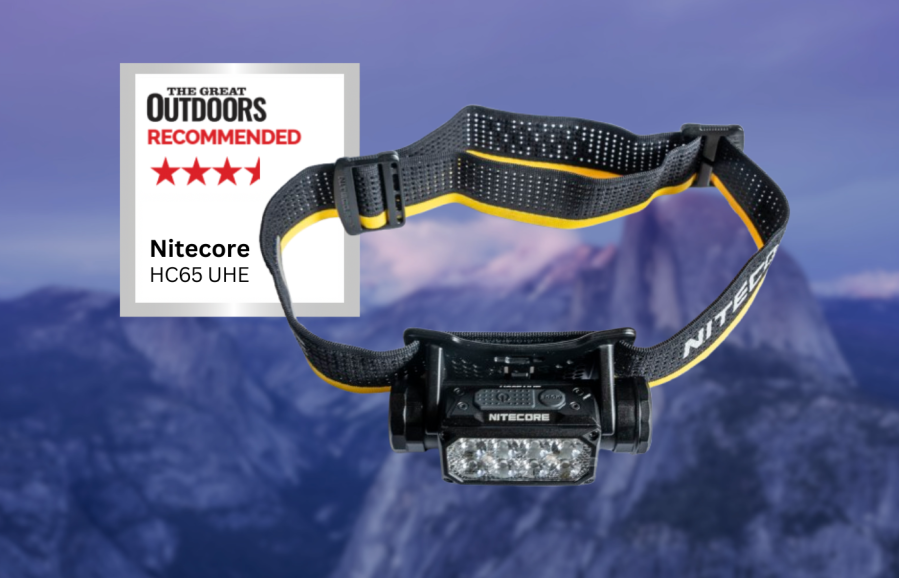
Chris Townsend recommends
This lamp offers more power than most users are likely to need – but there are benefits.- Powerful
- Battery life
- Waterproof
- Quite heavy
- Small button
| Quick Specs | |
|---|---|
| RRP: £94 | $120.57 Weight: 156g Power Source: 4000 mAh li-ion rechargeable battery Battery Life: 2 – 82 hours Brightness: 8 – 2000 lumens / 6 – 222 metres Features: 6 light levels, lock mode, waterproof (IP68), red light, storage case www.nitecore.co.uk |
If you want the brightest light and longest reach, the Nitecore HC65 UHE is the headlamp to choose from this review. In the Turbo mode it has 2000 lumens and throws a beam 222 metres. Unsurprisingly the battery then only lasts two hours.
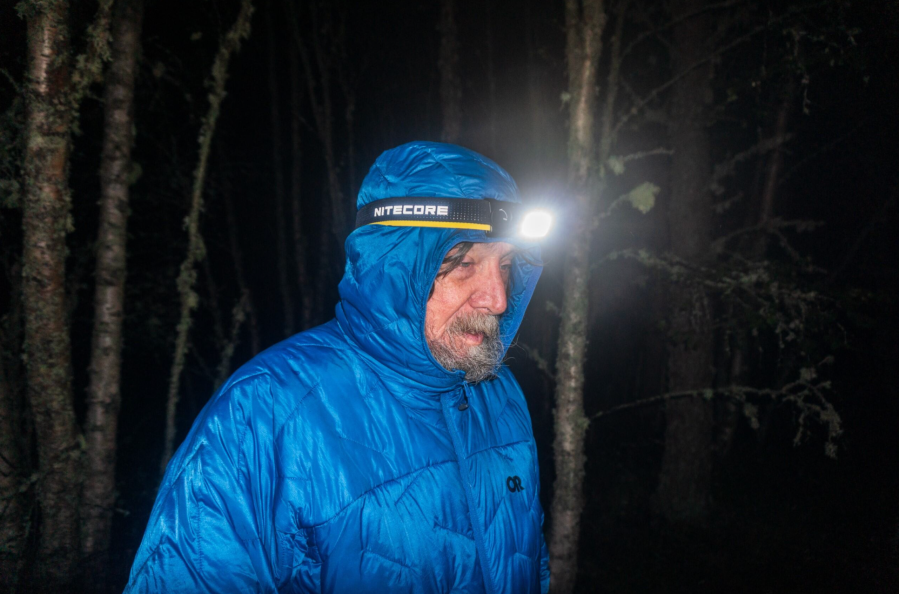
There are three other primary modes – Mid, High, and Higher – of which the first, which has a runtime of 31 hours, is okay for walking on good paths, and the second, with a runtime of 14 hours, good for difficult terrain. There is also an auxiliary light with Ultralow and Low settings that is fine around camp or in a tent.
This headlamp offers more power than most users are likely to ever need but on lower settings it does have good battery life.
Read Chris’ full review of the Nitecore HC65 UHE.
Biolite Head Torch 425
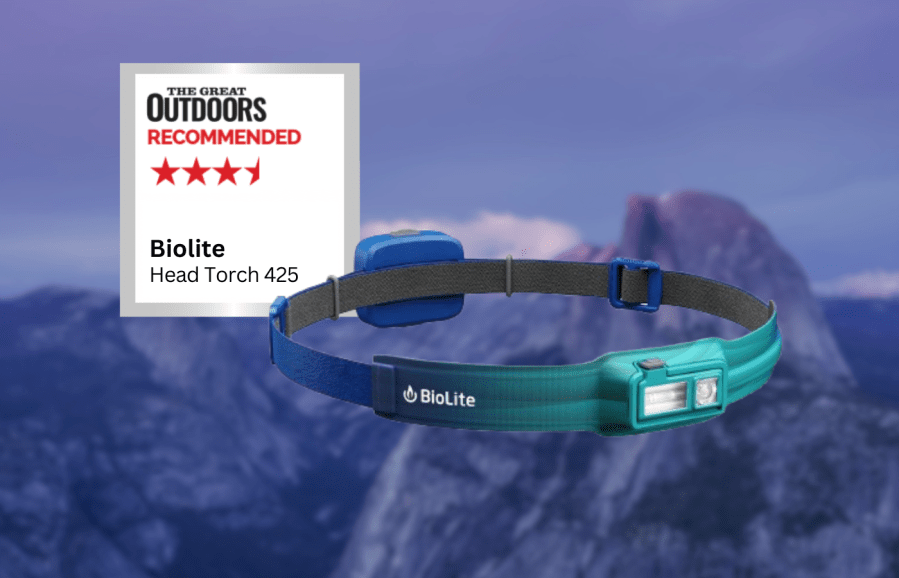
Chris Townsend recommends
A great lightwight back up for a more powerful lamp, this is a good head torch for the price.- Cost
- Lightweight
- Stable
- Dimmable light
- Not that powerful
- Small
| Quick Specs | |
|---|---|
| RRP: £65 | $83.28 Weight: 81g Power Source: 1000 mAh Li-ion rechargeable battery Battery Life: 4 – 60 hours Brightness: 5 – 425 lumens / 15-85 metres Features: 2 light levels, spot & flood beams, dimmable, red light, lock, splashproof uk.bioliteenergy.com |
The Biolite Head Torch 425 is the equal lightest headlamp reviewed and one of the lowest priced. It’s not that powerful but the highest setting is okay for walking, though that only lasts 4 hours. It has an excellent headband made of moisture wicking fabric that feels very comfortable. The battery pack is at the back with the cable mostly integrated into the headband though there is one external coiled section near the battery case. The lamp itself is small and almost flush with the headband.
The weight, compact size, comfortable headband, and price make the 425 attractive. I think it’s great for walks where you know you won’t be out in the dark for long, for use in camp, as back up to a more powerful lamp, and for carrying in summer when hours of darkness are short. I wouldn’t use it as my main torch in winter though.
Read Chris’ full review of the Biolite Head Torch 425.
Ledlenser HF8R Core
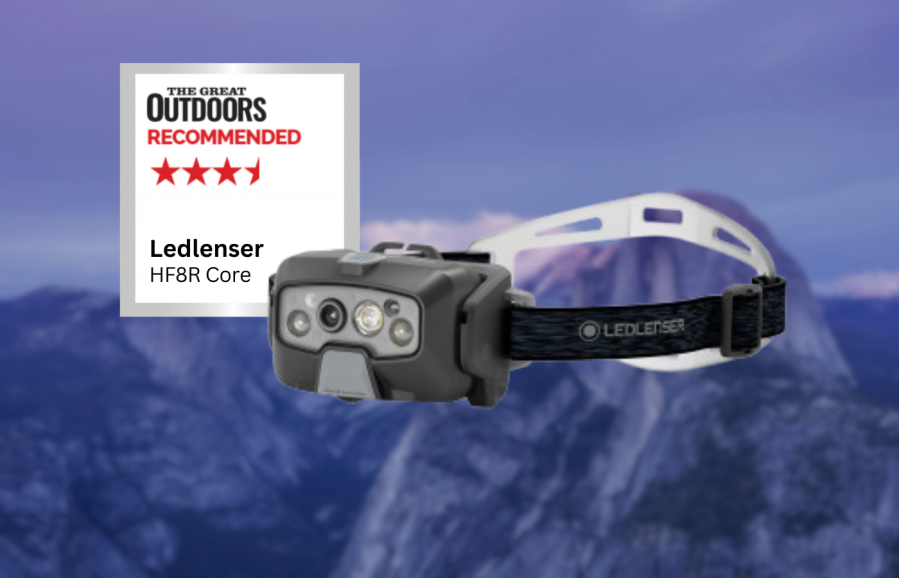
Chris Townsend recommends
A chunkier version of the HF6R, I’d like to see this otherwise excellent lamp shed some weight.- Auto dimming & focusing
- Control wheel
- Battery life
- Waterproof
- Heavy
- Proprietary charging system
- Expensive
| Quick Specs | |
|---|---|
| RRP: £120 | $153.87 Weight: 194g Power Source: 3700 mAh rechargeable Battery Life: 3.5 – 90 hours Brightness: 20 – 1600 lumens / 25 – 210 metres Features: 4 light levels, red light, dimming, seamless spot to flood focus, lock mode, waterproof (IP68) www.ledlenser.co.uk |
The Ledlenser HF8R Core is a chunky, heavy headlamp made from aluminium. It’s essentially a bigger more powerful version of the HF6R with one added feature called Adaptive Light Beam Technology. This means the light changes in brightness and focusing depending on where you’re looking, making it a hands free headlamp. It works well and I can’t really see any need to change to the separate light levels. These are more powerful than the ones on the HF6R but work in the same way and have the same control wheel for changing from spot to flood. The control wheel has no effective in Adaptive Light mode.
The HF8R Core has LedLenser’s proprietary charging system so you can only use the supplied cable not a USB one. The Adaptive Light system is excellent. I would like to see it in a smaller, lighter headlamp.
Read Chris’ full review of the Ledlenser HF8R Core.
Princeton Tec Remix
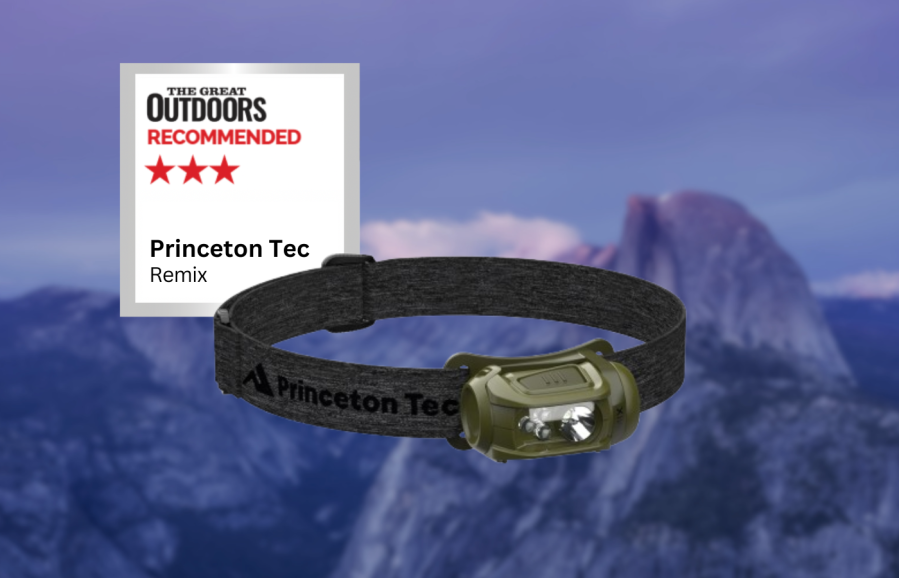
Chris Townsend recommends
The Remix is not the most powerful light I’ve tested but it makes up for it with a simple design using AAA batteries.- Lightweight
- Low cost
- Good battery life
- Stiff bracket
- No lock funtion
- No flood beam
| Quick Specs | |
|---|---|
| RRP: £60 | $76.96 Weight: 88g Power Source: 3 AAA batteries Battery Life: 6 – 63 hours Brightness: 100 – 450 lumens / 15.5m – 51 metres Features: 3 white light levels, two red light levels, splashproof (IPX4) www.princetontec.co.uk |
The Princeton Tec Remix is the only headlamp tested that doesn’t come with a proprietary rechargeable battery. Of course, rechargeable AAA batteries can be used. It is an advantage to be able to use standard batteries you can buy in many places.
The Remix is also lightweight, compact and low cost. It’s not the most powerful light but I found it fine when walking on most terrain. Only on rough steep ground would a more powerful light be useful for picking out a route in the distance. The Remix also has excellent battery life on full power. It only has a spot beam but this is actually quite wide and I didn’t miss a flood beam.
Read Chris’ full review of the Princeton Tec Remix.
Lifesystems Intensity 300
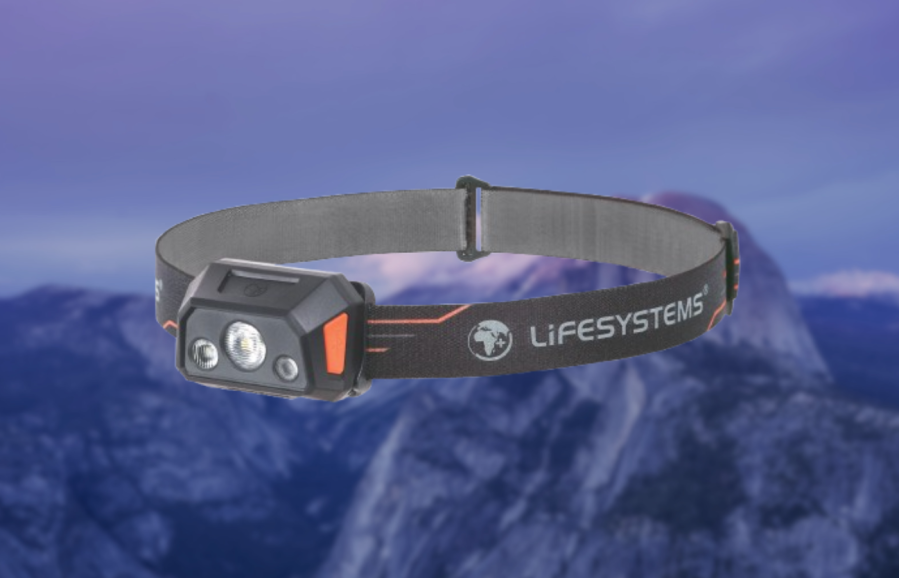
Chris Townsend’s verdict
With the exception of winter or harsh conditions, this is a good headlamp for the price.- Cost
- Big button
- Can’t toggle between modes
- No lock mode
- Short battery life
| Quick Specs | |
|---|---|
| RRP: £30 | $38.47 Weight: 194g Power Source: 1800 mAH Li-ion rechargeable Battery Life: 2 – 38 hours Brightness: up to 300 lumens / 10-65 metres Features: 3 light modes, red light, reflective headband, water-resistant (IPX6) www.lifesystems.co.uk |
The Lifesystems Intensity 300 is by far the least expensive headlamp tested and is great value for money. It’s not as powerful as many other headlamps but I found it adequate for most walking. There are three LEDs, two white, one red. The smaller white one only has one light level and that’s dim. It’s fine for close-up use – looking at maps, in camp – but not for walking except on a very smooth clear path. The larger LED has two light levels. With the brightest one the battery life is just two hours. However the lower level is okay on good paths and lasts several hours longer.
For the price this is a good headlamp. Outside of winter it should be fine for most walking except on very rough terrain where a brighter light would be useful.
Read Chris’ full review of the Lifesystems Intensity 300.
How we test
Chris tested these head torches on night walks and when camping in the Scottish Highlands, mainly the Cairngorms, throughout 2024. This comparative review was first published in the November 2024 issue of The Great Outdoors.
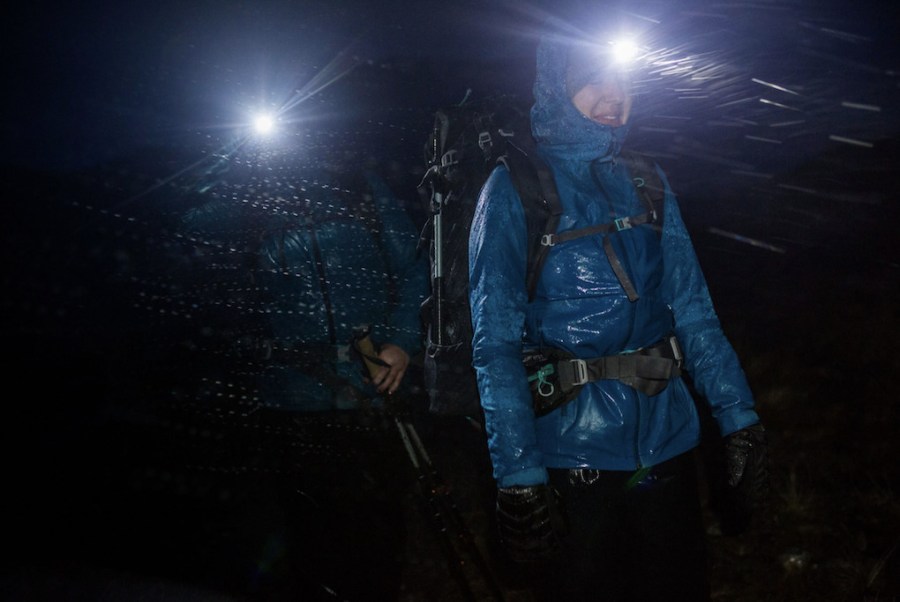
Features of the best head torches
Batteries
Lithium-ion rechargeable batteries are now the standard for headlamps. Most have proprietary batteries that can be changed for one the same, though some are sealed units. With some, standard batteries can also be used. A few headlamps still just run on the last, usually AAA size.
LEDs
LEDs come in different sizes with different light outputs. Large LEDs are very bright but also use battery power more quickly than smaller, weaker LEDs. The first are good for night hiking, the second for map reading, pitching tents, cooking and other camp chores. Red LEDs are good for use without spoiling your night sight. Straps Head straps need to be soft, comfortable, easily adjustable, and non-slip. The design should be adequate to support the weight of the headlamp.
Buttons and controls
Buttons should be easy to use with cold fingers or gloves whilst the lamp is on your head. Some headlamps have controls activated when you move your hand across them. A lock mode is useful to prevent buttons being accidentally pressed in your pack. Usable Light LEDs will continue to glow feebly as long as there’s a smidgeon of energy left in the batteries. This isn’t much use however. Makers’ maximum times are often those at which the light is just strong enough to be useful. Recharging or changing the batteries before this stage is reached is a good idea.
Light levels
All bar the simplest headlamps have variable light levels so you can have a very bright light for difficult terrain or identifying distant objects and less bright lights for close-up use and longer battery life. Mid-level is usually the best combination of brightness and battery life.
Beam
The beam can be a wide flood, which is useful for lighting a wide area such as a campsite, or a spot, which is useful for throwing the light the farthest distance and pinpointing a distant object, or a mix of both. As battery power drops so does the beam strength.
Pivoting Lamp
The lamp housing should pivot easily so the beam can be directed but be firm enough not to slip with movement.

